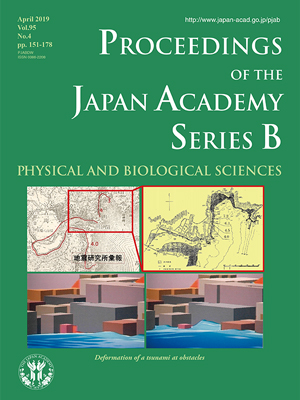About the Cover
Vol. 95 No. 4 (2019)
In the cover’s top photo are the results of the measurements of the 1933 Great Meiji Sanriku Tsunami in Miyako City, Iwate Prefecture. On the left are measured values by the earthquake research institute, showing the tsunami's height in Kuwagasaki reaching 3 and 4 meters with a solid line indicating the region of flooding. On the right are measured values from the Miyako Port restoration office with heights of 4 meters at one spot, and 7.2 meters at a spot just a dozen meters away. How did such a difference come about?
In 1987, this question was resolved through the making of the first tsunami video animation based on a tsunami numerical simulation, shown in the bottom two slides. The left image shows the moment the flooding tsunami hit the building. The waves could only go up after colliding. However, the waves on the side of the building continued to pass onwards, thus, generating a wave corresponding to the size of the obstacle. The image on the right shows the generated wave moving along with the next building. This is the phenomenon which caused the height difference in Kuwagasaki.
The development of the technology used to obtain the tsunami numerical simulation (the basis of the animation) began in the 1970s. In 1971, Mansynha-Smylie proposed a technique to obtain the groundr’s displacement from earthquake fault parameters. The vertical displacement that appears on the sea surface becomes the tsunami initial waveform. For the subsequent tsunami, the differential equation should be rewritten as a difference equation, then solved. However, control is necessary so that the calculations do not cause instability, and guarantee the accuracy to endure practical use. (Shuto, pp. 151-164)
These issues were resolved and a video was made in 1987. With this video, it was the first time a tsunami’s entire form could be seen, even among tsunami researchers. It has been also used in safety education and training for coastal residents. Although the Japan Meteorological Agency’s tsunami forecast is able to predict values corresponding to 3 or 4 meters in Kuwagasaki, the effects due to obstacles within the region cannot be predicted. Therefore, enough time is needed to escape.
The above method of numerical simulation for tsunamis was developed by Tohoku University and became the world standard technology in UNESCO’s Manuals and Guides No. 35 (Issue 1997).
Professor
Faculty of Societal Safety Sciences,
Kansai University




